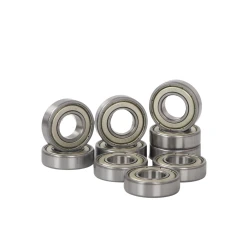Key points about ball bearings
2023-11-29
Ball bearings are a type of rolling-element bearing that uses balls to separate the moving parts of the bearing. They are designed to reduce rotational friction and support radial and axial loads. Ball bearings are widely used in various applications, ranging from household appliances to industrial machinery. Here are some key points about ball bearings:
1. Structure:
- Ball bearings consist of an outer ring, an inner ring, a cage, and balls. The balls are positioned between the inner and outer races and are held in place by the cage, preventing them from touching each other.
2. Types of Ball Bearings:
- Deep Groove Ball Bearings (Single Row): Commonly used for radial loads and moderate axial loads. They have a deep groove design, allowing them to accommodate high speeds.
- Angular Contact Ball Bearings: Designed to handle both radial and axial loads. They have contact angles that allow them to support axial loads in one or both directions.
- Self-Aligning Ball Bearings: Can accommodate misalignment between the shaft and housing, making them suitable for applications with shaft deflection or misalignment.
- Thrust Ball Bearings: Specifically designed to handle axial loads in a single direction.
3. Advantages:
- Low friction: Ball bearings offer low rolling resistance, reducing energy consumption and heat generation.
- High precision: They provide precise rotation and are commonly used in applications where precision is critical.
- Low maintenance: In many cases, ball bearings are sealed or shielded, requiring minimal maintenance.
4. Applications:
- Ball bearings are used in a wide range of applications, including electric motors, automotive components, industrial machinery, household appliances, and more.
- They are suitable for high-speed and moderate-load conditions.
5. Materials:
- The rings and balls of ball bearings are typically made of steel. Ceramic materials, such as silicon nitride or zirconia, are also used for certain applications where high speed, corrosion resistance, or other specific properties are required.
6. Seals and Shields:
- Ball bearings can have seals or shields to protect against contamination and retain lubrication. Sealed bearings are generally more effective in preventing contamination, while shielded bearings allow for more efficient heat dissipation.
7. Preloading:
- In some applications, ball bearings may be preloaded to reduce clearance and improve rigidity, especially in precision machinery.
When selecting a ball bearing for a specific application, factors such as load type, speed, temperature, and environmental conditions should be considered to ensure optimal performance and longevity.



